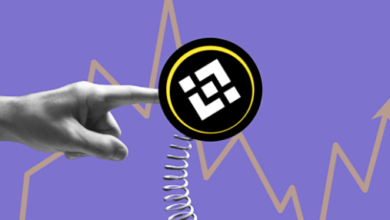Bitfinex P2p Holepunch Keetkhatri Theblock

The digital finance landscape has witnessed a significant rise in the adoption of peer-to-peer (P2P) trading, offering individuals a decentralized alternative to traditional financial systems.
One notable player in this space is Bitfinex, which has introduced an innovative P2P Holepunch technology. This article aims to explore the development of Bitfinex’s P2P Holepunch and the role played by Keetkhatri in its creation, providing insights into its inner workings and potential implications for the future of trading.
Bitfinex’s P2P Holepunch technology has emerged as a pioneering solution that facilitates direct communication between traders without relying on intermediaries. This decentralization empowers individuals with greater control over their financial transactions, aligning with the subconscious desire for freedom that many individuals possess.
The involvement of Keetkhatri in the development process brings expertise and insights into creating an efficient and secure system that addresses the challenges faced by traditional centralized exchanges.
By delving into the inner workings of Bitfinex’s P2P Holepunch technology, this article seeks to provide an objective analysis of its functionalities and mechanisms. Understanding how this technology enables secure peer-to-peer trading can help individuals make informed decisions about their participation in digital finance platforms.
Moreover, exploring the potential implications for the future of trading will shed light on how such innovations may shape and redefine financial systems, offering individuals even more autonomy and freedom in their financial endeavors.
The Rise of Peer-to-Peer Trading in the Digital Finance Landscape
The emergence of peer-to-peer trading has become increasingly prominent in the digital finance landscape, offering individuals a decentralized and user-friendly platform to engage in financial transactions without the need for intermediaries.
This form of trading brings several benefits in the context of decentralized finance. Firstly, it allows for direct interaction between buyers and sellers, eliminating the reliance on traditional financial institutions and their associated fees.
Additionally, peer-to-peer trading offers increased transparency as all transactions are recorded on a public ledger, ensuring accountability and reducing the risk of fraud. Furthermore, this decentralized approach provides individuals with greater control over their assets, as they can directly manage their funds without relying on third parties.
However, despite these advantages, there are also challenges and risks associated with peer-to-peer trading in digital finance. One major challenge is the potential lack of regulation or oversight, which can expose participants to scams or fraudulent activities.
Moreover, without intermediaries to facilitate dispute resolution or provide customer support services, users may face difficulties in resolving conflicts or addressing technical issues that may arise during transactions.
It is important for users to exercise caution and conduct thorough research before engaging in peer-to-peer trading to mitigate these risks effectively.
Bitfinex’s Innovative P2P Holepunch Technology
Utilizing an innovative peer-to-peer communication technique, Bitfinex has developed a technology that efficiently establishes direct connections between users, enhancing the overall efficiency and reliability of their platform.
P2P holepunch technology offers several advantages in the digital finance landscape. Firstly, it allows for faster and more efficient transactions by eliminating the need for intermediaries, reducing transaction costs and processing times.
Additionally, this technology enhances user privacy as it enables direct communication between users without relying on centralized servers that could potentially be vulnerable to hacking or data breaches. However, there are also limitations to consider when implementing p2p holepunch technology.
One limitation is the reliance on network infrastructure and connectivity, as any disruptions or poor network conditions can affect the functionality of this technology.
Moreover, security considerations are crucial when implementing p2p holepunch technology to ensure the protection of user data and prevent unauthorized access. Implementing robust encryption protocols and continuously monitoring for potential vulnerabilities is essential in maintaining a secure environment for users engaging in peer-to-peer transactions through Bitfinex’s platform.
The Role of Keetkhatri in the Development of P2P Holepunch
Keetkhatri played a significant role in the development of P2P holepunch technology, revolutionizing the way users establish direct connections and enhancing the overall efficiency and reliability of digital finance platforms.
Through his contributions, Keetkhatri introduced innovative techniques that allowed for seamless peer-to-peer communication, eliminating the need for intermediaries and providing users with greater control over their financial transactions.
His expertise in networking protocols and understanding of the challenges faced by decentralized platforms enabled him to design robust solutions that effectively addressed issues related to latency, scalability, and security.
By optimizing the holepunch technique, Keetkhatri not only paved the way for more efficient trading experiences but also contributed to creating a more inclusive financial ecosystem where individuals can transact directly without relying on traditional centralized institutions.
Ultimately, his role in innovation has empowered users with increased autonomy while establishing a foundation for future advancements in peer-to-peer technologies within the realm of digital finance.
Exploring the Inner Workings of Bitfinex’s P2P Holepunch Technology
Examining the intricate mechanisms of Bitfinex’s pioneering P2P holepunch technology reveals a sophisticated system that enables direct connections between users and enhances the efficiency and reliability of digital finance platforms.
Bitfinex has implemented robust security measures to ensure the safety of user transactions, including multi-factor authentication, encryption protocols, and real-time monitoring.
By facilitating direct peer-to-peer trading, this technology eliminates the need for intermediaries, allowing for faster and more cost-effective transactions.
The advantages of P2P trading are evident in its ability to promote financial inclusivity by providing access to individuals who may not have traditional banking services.
Additionally, P2P trading offers greater liquidity as it allows for direct interaction between buyers and sellers, resulting in more competitive prices.
Overall, Bitfinex’s P2P holepunch technology plays a crucial role in revolutionizing digital finance by offering enhanced security measures and unlocking the benefits of peer-to-peer trading for users worldwide.
See Also Employment 6.39m
Implications for the Future of Trading
The future of trading is poised to undergo significant changes as the implications of Bitfinex’s P2P holepunch technology are realized and embraced by the financial industry. This innovative technology has the potential to revolutionize traditional trading methods in several ways.
Firstly, it enables direct peer-to-peer trading without the need for intermediaries or centralized exchanges, providing traders with greater control over their transactions and eliminating associated fees. Additionally, this decentralized approach reduces counterparty risk and enhances privacy, as transactions occur directly between users’ wallets rather than through a third-party platform.
However, widespread adoption of P2P holepunch technology also presents potential challenges and risks. Regulatory concerns may arise due to the lack of oversight and transparency in peer-to-peer trading systems, potentially leading to increased scrutiny from regulatory authorities. Furthermore, security risks are inherent in any decentralized system, necessitating robust measures to protect user funds from hacking attempts or fraudulent activities.
Overall, while P2P holepunch technology holds great promise for transforming the future of trading by empowering individuals and promoting financial freedom, careful consideration must be given to address its potential challenges and ensure its secure implementation on a wider scale.
Frequently Asked Questions
How does peer-to-peer trading differ from traditional trading methods?
Peer-to-peer trading offers numerous benefits over traditional methods, including increased privacy and control, lower costs, and enhanced efficiency. Additionally, it has a positive impact on market liquidity by facilitating direct transactions between individuals without intermediaries or centralized authorities.
What are the advantages of Bitfinex’s P2P Holepunch technology over other peer-to-peer trading platforms?
Bitfinex’s p2p holepunch technology offers several advantages over other peer-to-peer trading platforms. It improves connectivity and enhances the efficiency of trades, resulting in faster transactions and increased liquidity. This has a significant impact on the trading industry by providing users with greater freedom and opportunities for profitable trades.
How did Keetkhatri contribute to the development of Bitfinex’s P2P Holepunch technology?
Keetkhatri played a pivotal role in enhancing Bitfinex’s p2p holepunch technology, significantly improving its efficiency. By implementing innovative techniques and addressing key challenges, Keetkhatri’s contributions have optimized the system’s performance and strengthened its ability to facilitate seamless peer-to-peer trading.
What are the technical aspects involved in the inner workings of Bitfinex’s P2P Holepunch technology?
The technical aspects of p2p holepunch technology involve establishing direct communication between two devices behind NATs by manipulating network protocols. Its functionality allows for efficient and secure peer-to-peer data transfer, enhancing user autonomy and freedom.
What potential changes or advancements in trading can be expected in the future as a result of Bitfinex’s P2P Holepunch technology?
Incorporating Bitfinex’s p2p holepunch technology may potentially revolutionize trading by enhancing market liquidity and paving the way for decentralized trading. This advancement can liberate traders from centralized exchanges, offering them a greater sense of freedom and autonomy.
Conclusion
In conclusion, the rise of peer-to-peer trading in the digital finance landscape has been a significant development that is transforming the way individuals engage in financial transactions.
Bitfinex’s innovative P2P Holepunch technology plays a crucial role in facilitating seamless and secure peer-to-peer trading experiences. By eliminating the need for intermediaries and allowing direct communication between traders, this technology streamlines the trading process and enhances transparency.
Concerns may arise regarding the security and reliability of P2P Holepunch technology. However, it is important to note that Bitfinex has implemented robust security measures to protect user data and ensure the integrity of transactions. Additionally, their continuous efforts to improve and refine this technology demonstrate their commitment to providing a safe and efficient trading environment.
The implications of Bitfinex’s P2P Holepunch technology for the future of trading are promising. As more individuals recognize the benefits of direct peer-to-peer transactions, we can expect to see a shift towards decentralized trading platforms. This could potentially disrupt traditional financial systems by reducing reliance on third parties and offering greater control over one’s assets.
Overall, Bitfinex’s P2P Holepunch technology represents an exciting advancement in the world of digital finance. Its ability to enable direct communication between traders offers numerous advantages in terms of efficiency, transparency, and control over financial transactions. While concerns about security may arise, it is evident that measures have been taken to address these issues.
As we look ahead, it is clear that peer-to-peer trading will continue to shape the future of finance by empowering individuals with greater autonomy over their assets.




